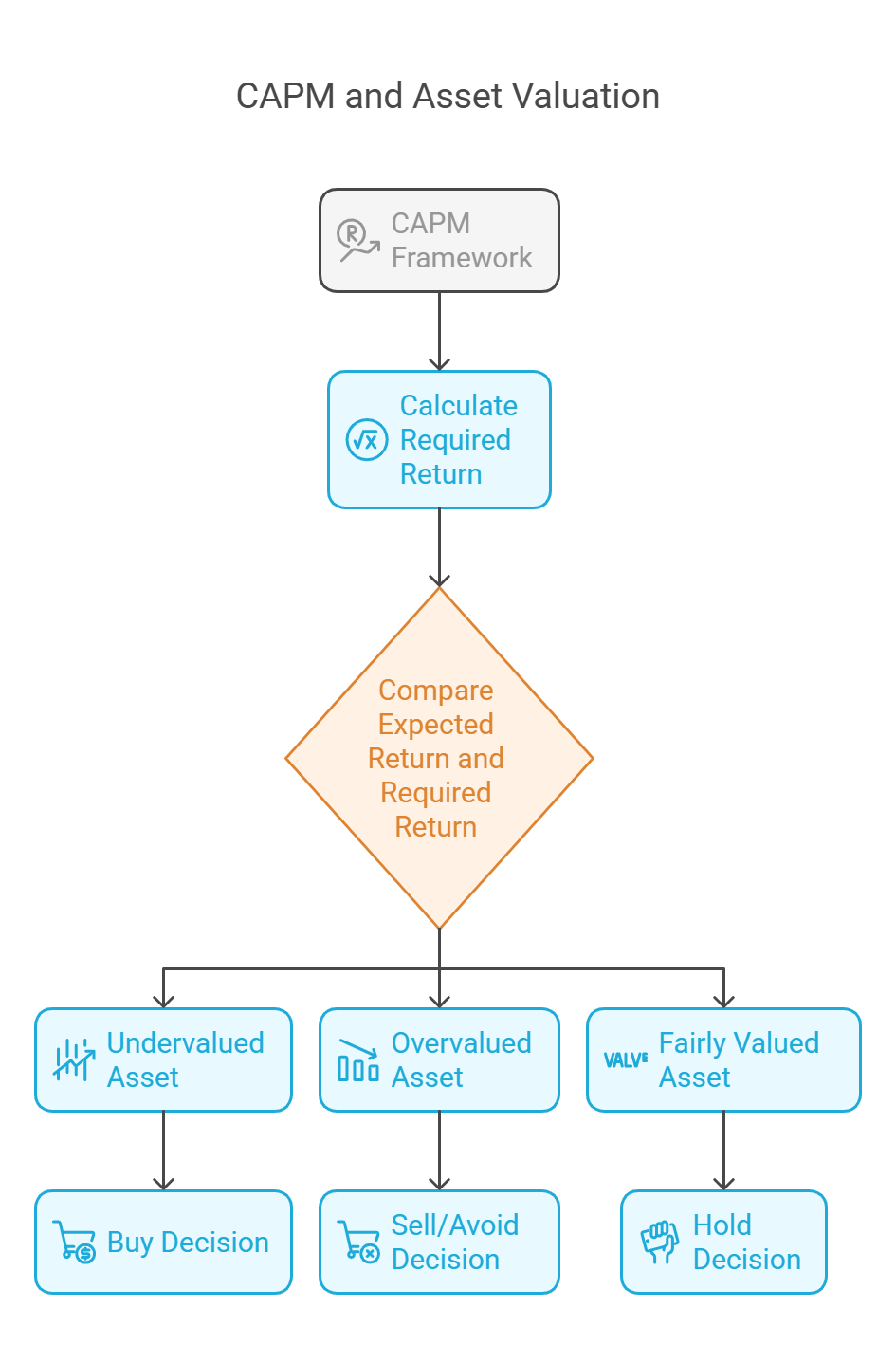Expected Return, Required Return, Overvalued and Undervalued Assets as per CAPM
Core Concept: The Capital Asset Pricing Model (CAPM) provides a framework for determining the required return on an asset based on its systematic risk (beta), the risk-free rate, and the expected market return. By comparing the required return to the expected return of an asset, investors can assess whether the asset is overvalued, undervalued, or fairly valued.
1. Expected Return (E(Ri))
- Definition: The expected return is the anticipated return on an asset based on an investor's own analysis and expectations. It represents the return that an investor believes they are likely to receive from the asset.
-
Estimation: The expected return can be estimated using various methods, including:
- Historical Data: Analyzing past returns to estimate future returns.
- Fundamental Analysis: Analyzing financial statements, economic data, and industry trends to forecast future earnings and cash flows.
- Analyst Forecasts: Relying on the forecasts of professional analysts who follow the asset.
- Subjectivity: The expected return is subjective and can vary depending on the investor's beliefs and assumptions.
-
Example:
- An investor analyzes a company's financial statements and projects that its earnings will grow by 10% per year for the next five years. Based on this analysis, the investor estimates that the stock will generate an expected return of 12% per year.
2. Required Return (r)
-
Definition: The required return is the minimum return that an investor needs to receive on an asset to compensate them for the risk they are taking. It represents the return that is justified by the asset's systematic risk (beta), the risk-free rate, and the expected market return.
-
CAPM Formula: The CAPM provides a formula for calculating the required return:
r = Rf + β * (E(Rm) - Rf)- Where:
-
r= Required return of the asset -
Rf= Risk-free rate -
β= Beta of the asset -
E(Rm)= Expected return of the market portfolio -
(E(Rm) - Rf)= Market risk premium
-
- Where:
-
Objectivity (Relative to Expected Return): The required return is more objective than the expected return, as it is based on market data and the asset's beta rather than subjective beliefs. However, it is still subject to the assumptions of the CAPM.
-
Example:
-
A stock has a beta of 1.2.
-
The risk-free rate is 3%.
-
The expected return of the market portfolio is 10%.
-
The required return of the stock is:
r = 3% + 1.2 * (10% - 3%) = 3% + 1.2 * 7% = 3% + 8.4% = 11.4%This means that an investor needs to earn at least 11.4% on this stock to be compensated for its risk.
-
3. Overvalued and Undervalued Assets
-
Comparison: By comparing the expected return of an asset to its required return, investors can assess whether the asset is overvalued, undervalued, or fairly valued.
-
a) Undervalued Asset:
-
Condition:
Expected Return > Required Return - Explanation: The asset is expected to generate a higher return than is justified by its risk. This suggests that the asset is trading at a price that is too low and that it is likely to increase in value.
- Investment Decision: Buy the asset.
-
Example:
- The stock in the previous example has an expected return of 12% but a required return of 11.4%.
- This suggests that the stock is undervalued and that investors should buy it.
-
Condition:
-
b) Overvalued Asset:
-
Condition:
Expected Return < Required Return - Explanation: The asset is expected to generate a lower return than is justified by its risk. This suggests that the asset is trading at a price that is too high and that it is likely to decrease in value.
- Investment Decision: Sell or avoid the asset.
-
Example:
- A stock has an expected return of 11% but a required return of 11.4%.
- This suggests that the stock is overvalued and that investors should sell it.
-
Condition:
-
c) Fairly Valued Asset:
-
Condition:
Expected Return = Required Return - Explanation: The asset is expected to generate a return that is exactly equal to the return that is justified by its risk. This suggests that the asset is trading at a fair price.
- Investment Decision: Hold the asset (if already owned) or make a decision based on other factors.
-
Example:
- A stock has an expected return of 11.4% and a required return of 11.4%.
- This suggests that the stock is fairly valued.
-
Condition:
4. Alpha (α) and CAPM
-
Definition: Alpha (α) represents the excess return of an asset over its expected return based on the CAPM. It measures the asset's performance relative to its expected return.
-
Formula:
α = Expected Return - Required Return-
α = E(Ri) - [Rf + β * (E(Rm) - Rf)]
-
-
Interpretation:
- Positive Alpha (α > 0): The asset has outperformed its expected return based on the CAPM. This suggests that the asset is undervalued.
- Negative Alpha (α < 0): The asset has underperformed its expected return based on the CAPM. This suggests that the asset is overvalued.
- Zero Alpha (α = 0): The asset has performed as expected based on the CAPM.
-
Example:
The CAPM provides a framework for assessing the value of assets by comparing their expected return to their required return. By understanding the concepts of expected return, required return, and alpha, investors can make more informed decisions about which assets to buy, sell, or hold. However, it's important to remember that the CAPM relies on several assumptions and that its predictions are not always accurate. Therefore, it should be used in conjunction with other investment tools and strategies.


No Comments